SEC Division of Examinations Releases 2026…

The container shipping industry had a hard time recovering from the global financial crisis and earnings have been extremely volatile in the last couple of years.

The container shipping industry had a hard time recovering from the global financial crisis and earnings have been extremely volatile in the last couple of years. Competition has been fierce and the main reason seems to be self-inflicted since the industry keeps on adding capacity and uses a wave of price wars to gain market share. Nevertheless, worldwide container throughput has increased almost 75% from 2005 till 2013 and the future looks promising. The main question, however, is if the ports and the hinterland transport infrastructure are ready to carry this growth and how they have to adapt to endure the current developments in the industry.
Basically, the industry consists of four major players. First of all, there are the shipping lines who take care of the ocean transport of the cargo. Secondly, the port authorities manage and maintain the port and offer concessions to the third player, the terminal operators. They load or unload the vessels and if necessary store the containers for transshipment. Finally, the containers also have to be transported to their final destination, which is done using the available hinterland transport infrastructure.
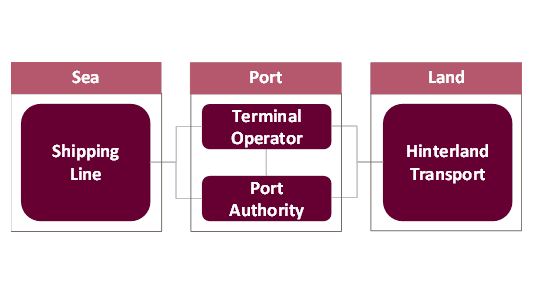
Overview of the container transport eco-system
Currently, there are around 400 container shipping companies and 5,100 container ships worldwide. Two major trends can be identified within the liner shipping market. On the one hand, carriers are building monster vessels, which are more than three times as big as 20 years ago. At the moment, the largest ship (MSC Oscar) can carry 19,224 TEU (twenty-foot equivalent unit) and several vessels with a capacity of over 20,000 TEU will set sail in 2017. It is expected that this trend will continue towards vessels with a capacity of at least 22,000 TEU. These slow steaming ultra‑vessels also consume 50% less fuel compared with the average on the main Europe-Asia route. The combination of the economies of scale and fuel savings allow the carriers to drastically decrease the cost per container and can cause rate differences up to 100% between competitors. It seems that capacity will only continue to increase, because the cost reduction strategy creates an enormous competitive advantage for the big players and the carriers will continue to use it in order to aggressively approach possible new clients and increase their earnings and market share.
On the other hand, the increased vessel size is pressuring carriers to come together in alliances in order to fully exploit the economies of scale. The larger vessels are increasing capacity significantly and this reinforces the already existing supply/demand imbalance, which makes it hard for the shipping lines to fill the ships and capture the associated benefits. Since 2011, the pressure for alliance size and geographical scope has only intensified. At the moment, there are four major global carrier alliances of which 2M (consisting of Maersk and MSC) is the biggest one and has a market share of 35%. Nevertheless, this does not mean that the market is becoming less competitive since the alliances only exist operationally and not commercially.

Main global carrier alliances and their market share
Both developments in the liner shipping market have a major impact on the ports and terminal operations. First and foremost, the current port infrastructure is under severe pressure since larger vessels require bigger approach channels and longer berths with deep enough water. Secondly, the larger vessels and alliances also cause fewer port calls and greater peaks at the terminals, which means that current port infrastructure is insufficient. This does not only ask for investments, but it also means that terminal operators and hinterland transport companies might have to operate with more flexibility in the future in order to carry the higher throughput peaks. It is also important to mention that these trends are not only affecting the biggest ports on the main ocean routes, but also the smaller ports since the current overcapacity of the container fleet tends to increase the vessel size on lower volume routes as well. This cascading effect will trigger a worldwide wave of investments, supported by the further container throughput growth.
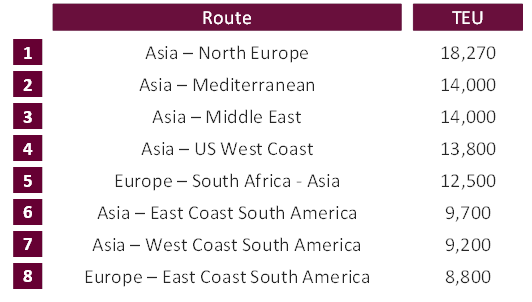
Largest deployed vessels per route (jan 2014)
In the following years, global container throughput is expected to grow at a compound annual growth rate (CAGR) of over 6%. Growth in container transport is highly related to GDP growth and hence follows the general economic cycle, but there are also other drivers which cause that the expected growth is outperforming world GDP forecast.

Global container growth and GDP forecast
First of all, there are the current changes in demographics and the increased globalization. Secondly, there is a modal transfer from break‑bulk, which means that a wider range of goods is being transported using containers. Container penetration grew from 22% to 67% between 1980 and 2012 and although the containerization level has reached its peak in the developed countries, it will continue to grow in the developing nations. Finally, transshipment has increased from 18% to 31% between 1990 and 2012 and the importance of it continues to grow, mainly because the shipping lines want to extend their network of ports at a lower cost.
The average GDP growth per region from 2014 till 2019 is shown in the world map below, which also visualizes the main ports in the world and summarizes the main drivers for port infrastructure investments. 24 out of the 50 biggest ports in terms of container handling are located in Asia and the biggest growth in the coming five years is also coming from the emerging and developing countries in Asia and Africa. The major constraints are that these regions currently do not have enough capacity to process the bigger container volume and connectivity to the hinterland is limited.
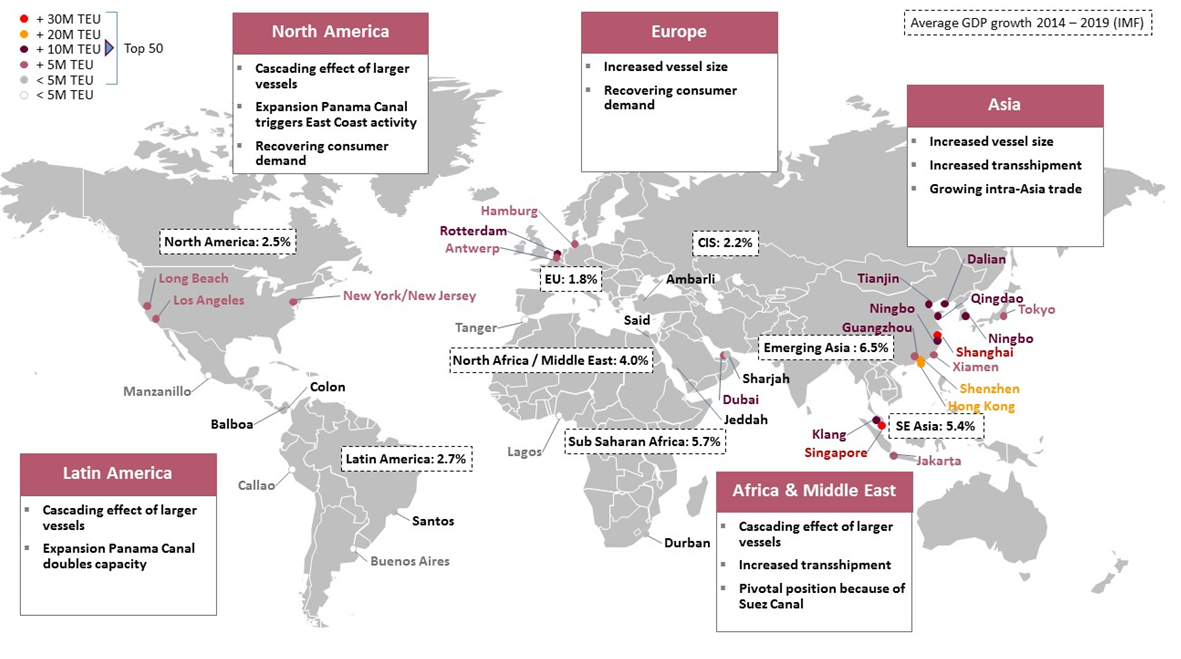
Main container ports, average GDP growth and driver for port infrastructure investments
The expected growth and the greater peaks caused by the larger vessels require upgrading of the current port infrastructure. If that is not enough, the growing importance of transshipment will even further increase the number of container movements and pressure the ports and terminals. Investments are necessary, otherwise ports will not be able to handle the larger quantities of cargo and shipping containers at once. The ports cannot even escape, since the increasing vessel size will also increase the competition between ports. If they are not able to receive the ultra-vessels, they will be left aside by the carriers and lose part of their business. Luckily, the big terminal operators realize that current infrastructure is underdeveloped and might constrain the expected growth, which is why 4 out of the 5 biggest global terminal operators have recently announced big upcoming port investments, especially in the emerging markets. On top of this, private participation in infrastructure (PPI) investments in seaports amounted to 8.38 billion euros in 2013, reaching an all-time record. Moreover, up to 2020, 430 container terminal projects can be identified globally, which will deliver approximately 560 million TEU of additional capacity.
The terminal operators, however, should not just blindly expand in order to process the greater container throughput peaks. They have to put fate in their own hands and improve their productivity so they can process the increasing container traffic in a more efficient way. Instead of only focusing on fixed infrastructure (e.g., quay length and height), they have to reduce loading and unloading time and improve the flexibility of the container handling equipment. First of all, carriers and terminal operators can better integrate planning and IT systems. This improves the communication and allows both parties to better prepare for the (un)loading process (e.g., provide enough manpower). Secondly, the terminals have to review their current ship‑to‑shore (STS) crane capacity and increase the degree of automation. The current cranes might not be big enough in terms of outreach and crane density over the quay has to be optimized. Likewise, the current yard equipment (RMG and RTG cranes) has to be examined and aligned with the output flow of the STS cranes. Next, the terminal operators cannot underestimate the importance of skilled and qualified employees, especially with the trend towards terminal automation. Finally, just like the carriers, the terminal operators can also implement greater coordination among each other and create partnerships to expand their capacity to larger scales when necessary. This would also reduce inter-terminal transfers or separate calls at different terminals in one port. It seems to be already happening since merger and acquisition activity has intensified the last years and increased internationalization is observed within the market of terminal operators.
The hinterland infrastructure (road, barge and rail) cannot be forgotten in this picture and has to be developed at the same time to support the upcoming growth. As seaports are increasing their amount of goods traded and are investing in order to increase its capacity, sufficient infrastructure is needed to transport these goods to the hinterland. An inefficient hinterland transport system will backfire on overall port efficiency and increase the turnover time and cost per container, which is the opposite of what the industry wants. On a global scale, especially Latin America and Africa have to improve their hinterland connectivity in order to optimally benefit from the future economic growth. In Europe, the European Union created a mobility and transport plan (TEN-T) with a budget of 26 billion euro in order to improve the overall European core transport network.
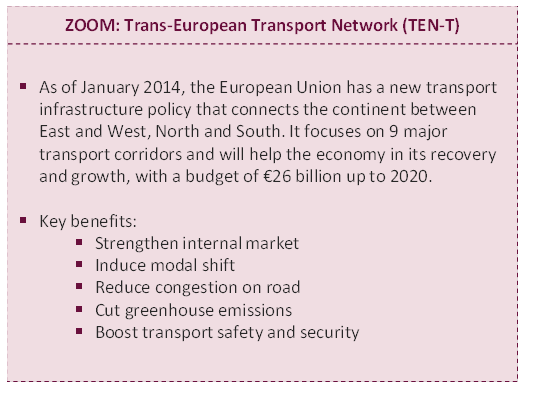
Hinterland investment plan in Europe
As an example, the Port of Antwerp is considered, where 4.4 million containers (75% of all containers) were transported to the hinterland in 2013. With a growth rate between 3% and 5% until 2020, the amount of containers that have to be transported outside of the port will only increase in the following years. Nowadays, 56% of all containers leaving Antwerp is done by road. An expected modal shift towards barge and train will offset a large part of the road transport growth, which means that the amount of containers to be transported by road is forecasted to remain flat or will just slightly increase. The increase of container volume economically justifies the use of barge and train, because they respectively become more beneficial for big volumes and long distances.

Modal shift for container transport in Antwerp
As a response, the Port of Antwerp and its partners are executing a wide range of major infrastructure projects and they try to continuously improve the efficiency between the port and its hinterland.
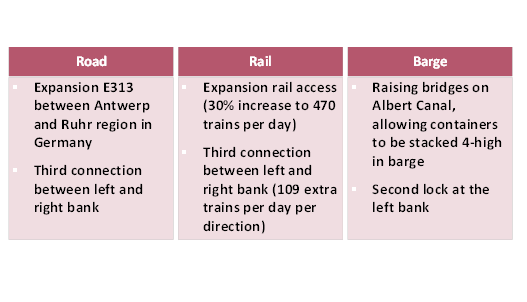
Overview hinterland investments in Antwerp
Other new initiatives like the Antwerp Port Community System (APCS), the Port of Antwerp Intermodal Solutions & Connectivity Platform, an Automatic Identification System (AIS) and a Barge Traffic System (BTS) try to improve the communication between the different players. This accelerates the in- and outflow of the containers which will help them to endure the higher throughput peaks. The main goal is to streamline the processes by creating strong collaborations between all supply chain partners. The question is if these efforts are sufficient or if they will have to introduce additional flexibility in the workforce to process the extra container throughput.
The introduction of bigger vessels is completely changing the nature of container port demand. The shipping carriers are imposing higher container throughput peaks on the other industry players and combined with the weight of worldwide growing demand, terminal and hinterland infrastructure are under severe pressure. At the moment, the trend towards bigger vessels is unstoppable because it reduces costs significantly and it creates a substantial competitive advantage for the carrier.
Moreover, the shipping lines are forcing the ports to adapt and they are leaving them no other option than to invest or otherwise they will be outcompeted by other ports nearby. On the one hand, the ports will have to expand in order to welcome the bigger vessels and increase their container handling capacity. On the other hand, terminal operators and hinterland transport companies have to improve their productivity and accelerate the container flow. This is mainly done by optimizing the use of the container handling equipment and introducing communication systems to coordinate the information in the supply chain. The productivity can be even further improved if the terminal operators and hinterland transporters introduce a flexible workforce. This will allow them to process the higher throughput peaks, but will also increase the return on their assets.